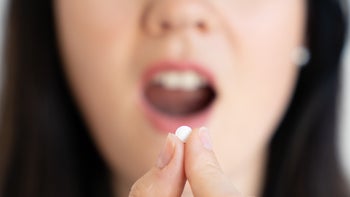
Buprenorphine Dosages for Adults: Your GoodRx Guide
Key takeaways:
Oral buprenorphine is a medication that treats opioid use disorder (OUD). If you’re prescribed buprenorphine, you’ll likely start with a low dosage of 2 mg to 4 mg daily. Depending on how you respond, your buprenorphine dosage may be increased to up to 16 mg to 24 mg daily.
You shouldn’t start buprenorphine treatment too soon after your last dose of opioids. Be honest with your prescriber about when you last took opioids. They can let you know when it’s safe to take your first buprenorphine dose.
If you miss a dose of buprenorphine, take it as soon as you remember. Though, if it’s close to the time for your next dose, skip the missed one and follow your regular medication schedule. If you miss more than one dose, let your prescriber know.
Access savings on related medications
Table of contents

Buprenorphine is a medication that treats opioid use disorder (OUD). It’s used as part of a treatment method called medication-assisted treatment (MAT), which combines medication, therapy, and support systems to treat OUD.
Buprenorphine is considered a first-choice medication for treating OUD. But taking the correct buprenorphine dosage is important to getting the most out of the medication while also staying safe.
Buprenorphine isn’t approved for use in children, so this article will discuss treatment details for adults only.
What forms of buprenorphine are available to treat OUD?
There are several buprenorphine products available to treat OUD. Products that contain buprenorphine on its own come in the following forms:
Sublingual tablets
Some products contain a combination of buprenorphine and naloxone. These products come in the following forms:
Sublingual tablets (Zubsolv)
Sublingual film (Suboxone)
Buprenorphine / naloxone products are preferred by prescribers over buprenorphine-only products for treating OUD. Most experts believe the naloxone component helps people avoid misusing buprenorphine. Though, some evidence shows this might not be true.
Good to know: In this article, we’ll focus on oral (sublingual) buprenorphine dosages for OUD. But there are other buprenorphine products that are FDA approved to treat chronic pain. These include a skin patch (Butrans), buccal film (Belbuca), and a short-acting injection. While these forms aren’t approved to treat OUD, they may be useful in people with chronic pain and OUD.
What’s the typical oral buprenorphine dosage for adults?
There are two phases to buprenorphine treatment for OUD: induction and maintenance.
The induction phase is the period when you first start taking buprenorphine and are figuring out the right dosage. Then, during the maintenance, you take buprenorphine at a consistent dosage. We’ll go through both of these phases below.
Induction phase
The induction phase of buprenorphine treatment can be done at home or in your prescriber’s office. If you’re given a choice, there are pros and cons to both options to consider. Talk to your prescriber about which method they think is best for you.
Induction usually takes 2 to 4 days. On Day 1, the initial buprenorphine dosage is typically somewhere between 2 mg to 4 mg. Based on how you respond, your prescriber may instruct you to take more buprenorphine later in the day. Then, your dosage will continue to be tweaked over several days.
Below are a few important facts about buprenorphine induction:
Starting treatment with buprenorphine too soon after your last opioid dose can lead to what’s known as “precipitated withdrawal” symptoms. This is because buprenorphine itself is an opioid, though it’s not as strong as other opioids. It attaches to the same receptors that other opioids do, but it binds more tightly. So if you have opioids in your system and you take buprenorphine, buprenorphine will knock the opioids off their receptors and cause precipitated withdrawal, which feels similar to opioid withdrawal.
With short-acting opioids like hydrocodone, you typically need to wait at least 6-12 hours after your last dose before starting treatment with buprenorphine. With long-acting opioids like morphine (MS Contin) and extended-release oxycodone (Oxycontin), you typically need to wait 24-72 hours.
To determine when it’s safe for you to start taking buprenorphine, your prescriber will ask if you’re experiencing opioid withdrawal symptoms. They may also use a rating scale called the Clinical Opiate Withdrawal Scale (COWS). This information will help them understand whether your last opioid dose is wearing off.
Opioid withdrawal symptoms include increased sweating, runny nose, and upset stomach. You may also experience trouble sleeping, muscle aches, and diarrhea. Keep track of any symptoms you experience so you can tell your prescriber about them.
Maintenance phase
After the induction phase is complete, you may still need buprenorphine dosage adjustments at some point. Frequently update your prescriber on how you’re doing, including whether you’re having cravings for opioids. This may be an indication that you need a higher buprenorphine dosage. Or if you’re experiencing buprenorphine side effects — like constipation, nausea, or trouble sleeping — you may need a lower dosage. But don’t make any changes without talking to your prescriber first.
In the maintenance phase, buprenorphine is usually taken once a day (though some people may need more frequent doses). Buprenorphine dosages typically range from 4 mg to 16 mg per day. The maximum daily dose is 24 mg, but higher dosages are associated with more risks, including a greater risk for side effects and misuse.
Some research shows that higher buprenorphine dosages help people stick with treatment longer. This may be especially true for people who were taking illegally made fentanyl, which is more likely to cause overdose than other opioids. It’s possible that you may need a higher buprenorphine dosage if you were taking fentanyl, which is extremely potent.
Are there any dosage adjustments for health conditions?
Buprenorphine is broken down in the liver. If you have moderate-to-severe liver damage, you may need a lower buprenorphine dosage. This helps minimize your risk of experiencing buprenorphine side effects like constipation and nausea. It also minimizes your risk of experiencing an overdose. Though, buprenorphine overdoses are rare when the medication is not combined with other opioids.
How long will you have to take buprenorphine? [Treatment duration]
How long you will need to take buprenorphine depends on your individual situation. Given the risks of experiencing relapse, the benefits of taking buprenorphine long term often outweigh the potential downsides. Some people take buprenorphine indefinitely for this reason.
Research shows that people who stop taking buprenorphine are at increased risk of experiencing relapse with opioids, hospital visits, and overdose. Some research shows these risks are higher for people who take buprenorphine for less than 9 months, compared to those who take it for a longer period (15 to 18 months).
If you’re interested in stopping treatment with buprenorphine, talk to your prescriber first. They can help you weigh the risks versus benefits of stopping treatment. If you decide to stop taking buprenorphine, work with your prescriber to lower your dosage over time. The amount of time it takes to taper off the medication varies based on the individual.
What happens if you miss a dose of buprenorphine?
If you miss a dose of buprenorphine, take it as soon as you remember. If it’s almost time for your next dose, skip the missed one. Don’t take two doses at once to make up for a dose you missed.
If you’ve missed more than one dose of buprenorphine, contact your prescriber. Missing several doses in a row can put you at increased risk of relapse. If you miss several days’ worth, you may need to restart buprenorphine at a lower dosage. Your body can lose its tolerance to buprenorphine if you don’t take it consistently, and this can put you at increased risk of side effects and, in rare cases, overdose.
What should you do if you take too much buprenorphine?
When taken on its own, buprenorphine is less likely to slow breathing or cause an overdose than other opioids. However, if you take too much or take it differently than how it’s prescribed, overdose is possible. Overdose is also more likely if you take other medications or substances that can slow breathing, such other opioids, benzodiazepines, and alcohol.
Signs of buprenorphine overdose are consistent with those of other types of opioid overdose. These signs include slowed breathing and heart rate. You may also feel limp, start vomiting, or lose consciousness.
An overdose is a medical emergency. Anyone witnessing an overdose should first call 911. Then, naloxone (Narcan) should be administered if it’s available. Naloxone is a fast-acting medication that can reverse the effects of an opioid overdose. It comes as a nasal spray and injection.
In recent years, naloxone has become more widely available, so you may be able to find it for free or over the counter. It’s strongly recommended to have naloxone available at all times if you or a loved one takes buprenorphine.
Can you continue buprenorphine if you experience relapse? [Relapse]
Experiencing relapse with opioids isn’t always a reason to stop buprenorphine treatment. But you should contact your prescriber immediately if you experience relapse, which can increase your risk of overdose.
Your prescriber can work with you to get back on track in your recovery. This may include having more frequent check-ins, encouraging you to engage in more therapy or support groups, or increasing your buprenorphine dosage.
How to save on buprenorphine for OUD
GoodRx can help you save over 80% off the average retail price of generic buprenorphine tablets. The price for 60 tablets of buprenorphine 8 mg may be as low as $42.53 with a free GoodRx coupon.
The bottom line
Oral buprenorphine is a prescription-only medication that treats opioid use disorder (OUD). If you’re prescribed buprenorphine, you’ll work closely with your healthcare professional to find the best dosage for you. You’ll likely start with a low dosage of 2 mg to 4 mg daily. Over several days of treatment, your buprenorphine dosage may be increased to up to 16 mg to 24 mg daily.
Depending on what opioids you were taking, you may have to wait between 12 to 24 hours after your last dose, and sometimes longer, before starting treatment with buprenorphine. Starting buprenorphine treatment too soon can cause withdrawal. So be honest with your prescriber about when you last took opioids.
Why trust our experts?


If you or someone you know struggles with substance use, help is available. Call SAMHSA’s National Helpline at 1-800-662-4357 to learn about resources in your area.
References
American Society of Addiction Medicine. (2020). The ASAM national practice guideline for the treatment of opioid use disorder: 2020 focused update.
Blazes, C. K., et al. (2020). Reconsidering the usefulness of adding naloxone to buprenorphine. Frontiers in Psychiatry.
Chambers, L. C., et al. (2023). Buprenorphine dose and time to discontinuation among patients with opioid use disorder in the era of fentanyl. JAMA Network Open.
Correct Rx Pharmacy Services, Inc. (2023). Buprenorphine - buprenorphine tablet [package insert].
Fiellin, D. A., et al. (2014). Primary care-based buprenorphine taper vs maintenance therapy for prescription opioid dependence: A randomized clinical trial. JAMA Internal Medicine.
Infantino, R., et al. (2021). Buprenorphine: Far beyond the ‘ceiling’. Biomolecules.
IT MATTTRs. (n.d.). A patient’s guide to starting buprenorphine at home. American Society of Addiction Medicine.
Kumar, R., et al. (2023). Buprenorphine. StatPearls.
LiverTox: Clinical and Research Information on Drug-Induced Liver Injury. (2020). Buprenorphine. National Institute of Diabetes and Digestive and Kidney Diseases.
National Institute on Drug Abuse. (2023). Higher buprenorphine doses associated with improved retention in treatment for opioid use disorder.
Shulman, M., et al. (2019). Buprenorphine treatment for opioid use disorder: An overview. CNS Drugs.
Substance Abuse and Mental Health Services Administration. (n.d.). Buprenorphine quick start guide.
U.S. Food and Drug Administration. (2023). Information about medication-assisted treatment (MAT).
Wesson, D. R., et al. (2003). The Clinical Opiate Withdrawal Scale (COWS). Journal of Psychoactive Drugs.
Wightman, R. S., et al. (2021). Opioid overdose deaths with buprenorphine detected in postmortem toxicology: A retrospective analysis. Journal of Medical Toxicology.
Williams, A. R., et al. (2020). Acute care, prescription opioid use, and overdose following discontinuation of long-term buprenorphine treatment for opioid use disorder. The American Journal of Psychiatry.
Was this page helpful?
Related Articles
Browse medications
View AllResearch prescriptions and over-the-counter medications from A to Z, compare drug prices, and start saving.



















